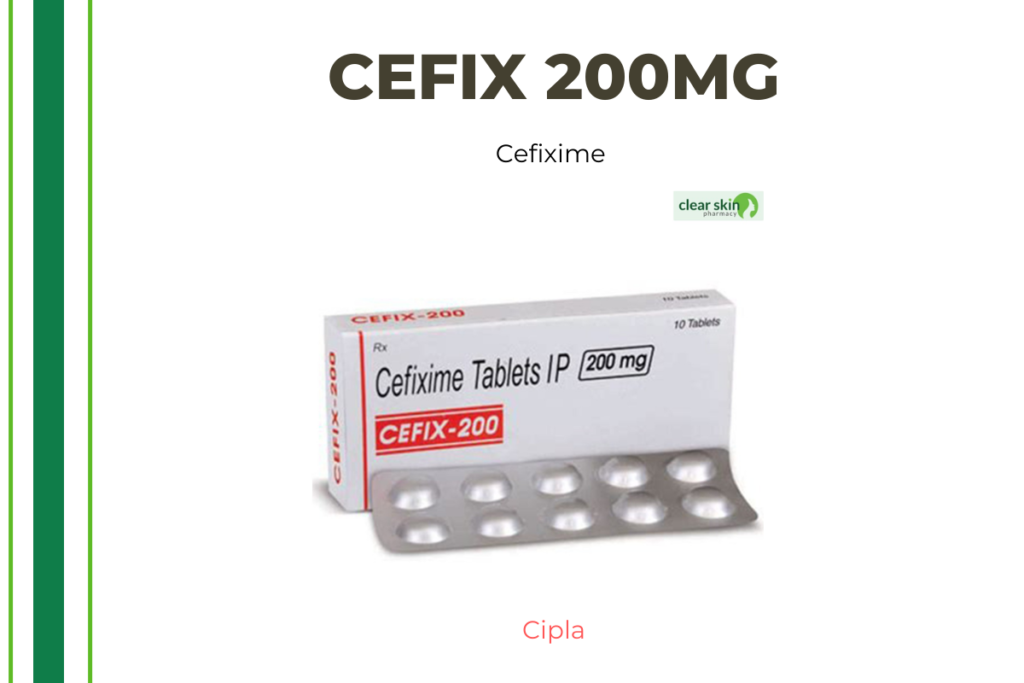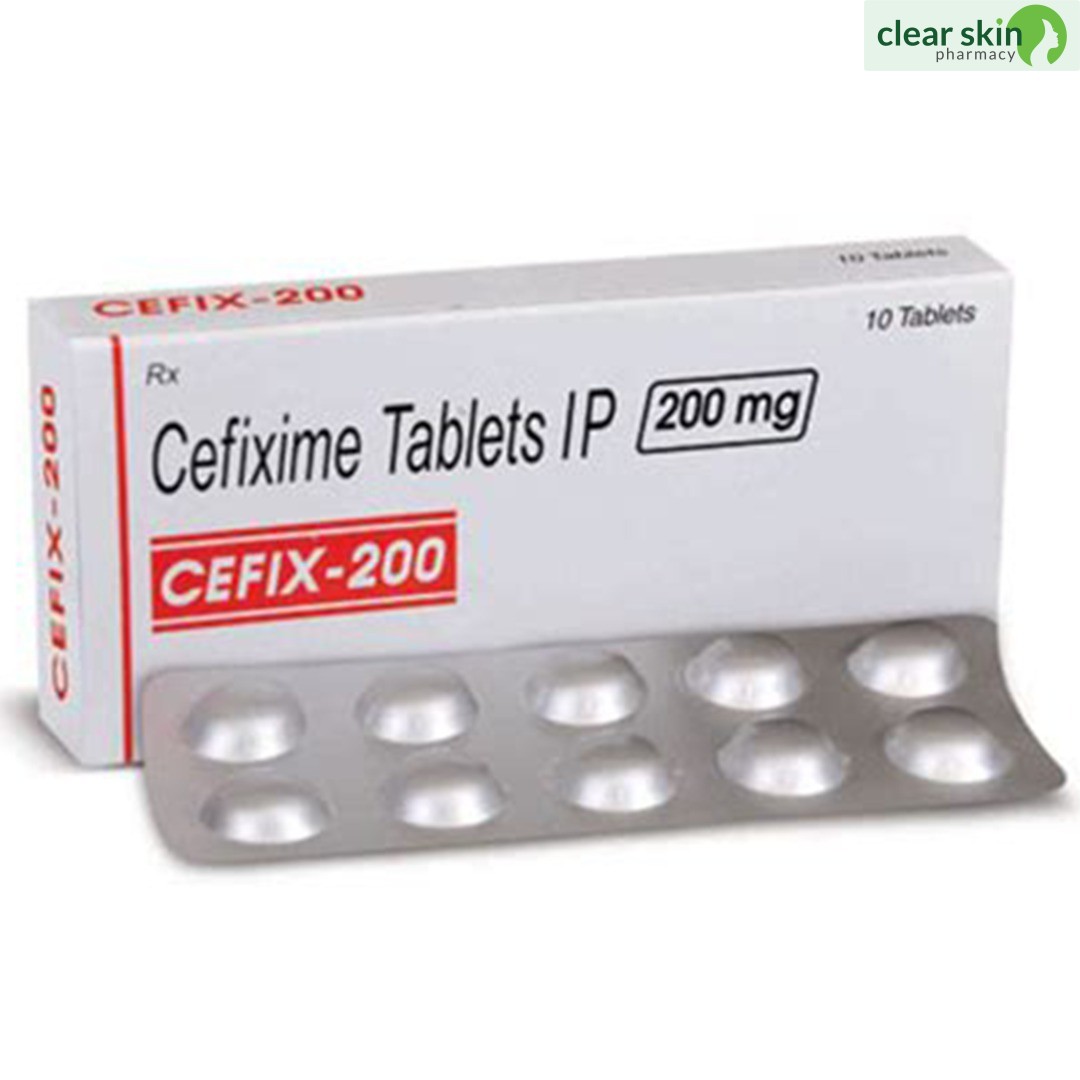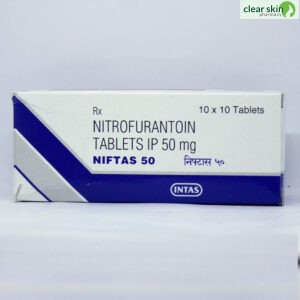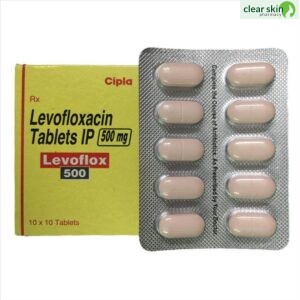Cefix 200 mg
Commonly used to treat bacterial infections of the ears, airways, and urinary tract, Cefix 200 mg is a cephalosporin antibiotic. Additionally, it is utilized to treat sexually transmitted diseases (STDs) (Sexually Transmitted Diseases). Bacteria that are either infectious or harmful can rapidly proliferate and cause illness. These dangerous bacteria produce toxins, which can cause tissue injury and illness.
Cefix 200 mg eliminates bacteria by inhibiting the chemical (mucopeptides) produced by the outermost layer of the bacteria (cell wall). As a result, Cefix 200 mg diminishes and destroys the bacterial cell wall. It is a broad class of antibiotics used to treat a variety of microorganisms. Cefix 200 mg is ineffective against the common cold, influenza, and other viral infections.
Cefix 200 mg should be taken precisely as prescribed by your physician, preferably with food to reduce gastric upset, and at regular intervals throughout the day for maximum efficacy. The appropriate dosage of Cefix 200 mg depends on your health and the severity of your infection. Since it’s an antibiotic, it’s also advisable to complete the entire course of treatment, even if you feel better. Skipping it could result in a more severe illness that doesn’t respond to the antibiotic (antibiotic resistance). Cefix 200 mg frequently causes diarrhea, nausea, irregular stools, stomach discomfort, dyspepsia (indigestion), and vomiting. Everyone does not have to experience the above adverse effects. If you experience sudden wheezing, constriction in the chest or neck, difficulty breathing, swelling of the eyelids, face, or lips, rash, or itching (especially if it affects your entire body), CONSULT A DOCTOR IMMEDIATELY AND CEASE TAKING YOUR MEDICATION.
Before beginning Cefix 200 mg, please inform your doctor if you are allergic to any antibiotic or if you have kidney or liver problems. Self-medication with 200 mg of Cefix may result in antibiotic resistance, which is the ineffectiveness of antibiotics against certain bacterial diseases. Consult your doctor before using Cefix 200 mg if you are pregnant, breastfeeding, suspect you are pregnant, or intend to have a child. Cefix 200 mg is, as far as we know, safe to ingest during pregnancy. During treatment with cefixime, it may be necessary to temporarily cease breastfeeding.
Cefix 200 milligrams is utilized for numerous purposes.
Some of the most common maladies include urinary tract infections (UTI), upper respiratory tract infections (URTI), lower respiratory tract infections (LRTI), gonorrhea (cervical/urethral), ear infections (acute otitis media), pharyngitis (pharyngeal inflammation), and tonsillitis (inflammation of the tonsils).

Medicinal Advantages
Cefixime is a short-term antibiotic used to treat a wide range of bacterial infections. It inhibits the growth of bacteria by impeding the formation of a necessary protective layer for their survival. It prevents and treats bacterial infections, including urinary tract infections (UTI), upper respiratory tract infections (URTI), lower respiratory tract infections (LRTI), gonorrhea (cervical/urethral), ear infections (acute otitis media), pharyngitis (pharyngitis irritation), and tonsillitis (inflammation of the tonsils). Additionally, it helps prevent infection after wounds, surgery, or dental procedures, along with sexually transmitted diseases, bone infections, and scarlet fever (bacterial illness with strep throat).
Cefixime Side Effects
Similar to other medications, cefixime can cause side effects, though not everyone experiences them. Diarrhea, nausea, loose stools, stomach pain, dyspepsia (indigestion), and vomiting are among the most common side effects of Cefixime. The majority of adverse effects of Cefixime do not require medical treatment and diminish with time. However, if the negative effects persist, consult a physician. In addition, if you experience sudden wheezing, chest or throat constriction, difficulty breathing, swelling of the eyelids, face, or lips, rash, or itching (especially affecting your entire body), STOP TAKING YOUR MEDICINE and seek immediate medical attention.
Recommendations for Drugs
Do not use it if you are allergic to Cefixime or other macrolide antibiotics. Cefixime is associated with hypersensitivity reactions, such as shock and mortality. If you experience an adverse reaction, discontinue use immediately and contact your doctor. Inform your doctor if you have a liver condition (jaundice), a muscle condition (myasthenia gravis), a cardiac rhythm disorder (arrhythmia), or an electrolyte imbalance (low potassium or magnesium level). Cefixime can induce diarrhea in some individuals; if you develop watery or bloody diarrhea, discontinue use and consult a physician. However, wait until your doctor prescribes anti-diarrhea medication. It is unknown whether the use of Cefixime during pregnancy causes harm to the fetus. Consult a physician prior to taking Cefixime if you are pregnant, planning a pregnancy, or nursing.
Interactions Between Medications
Live cholera vaccine, live typhoid vaccine, and Bacillus Calmette-Guérin vaccine may be less efficacious when administered concurrently with 200 mg Cefix (is used in a solution to stimulate the immune system in the treatment of bladder cancer and as a vaccine to prevent tuberculosis). To ensure proper vaccination response, you must wait at least 14 days after completing your antibiotic medication before receiving any of the vaccines listed above. Cefix 200 mg can cause renal problems in some patients, and taking it with furosemide may exacerbate the condition.
Avoid consuming a high-fat meal because your body will have a harder time assimilating 200 mg of Cefix. Consuming grapefruit during an antibiotic course may inhibit the body’s utilization of Cefix 200 mg. Therefore, citrus and grapefruit juice should be avoided when taking antibiotics. Consuming excessive quantities of calcium-fortified foods and beverages may reduce the efficacy of Cefixime.
Patients with diabetes, renal failure, liver disease, seizure disorders, or colitis should not take cefixime (a bowel disease that affects the large intestine and causes irritation, inflammation, and ulcers in the colon).
Emergency Suggestions
ALCOHOL
When taking medication, it is essential to avoid alcohol.
PREGNANCY
Cefixime should only be administered during pregnancy if absolutely necessary. Before prescribing it to you, your doctor will weigh the benefits and any potential risks. Please consult with a physician.
BREAST FEEDING
Cefixime should only be administered to lactating mothers if the benefits of treatment outweigh the risks to the infant. Therefore, it is essential to seek medical advice prior to using Cefixime.
DRIVING
Drive with caution because Cefixime frequently induces drowsiness and disorientation, which impairs driving ability.
LIVER
Use cefixime with caution, particularly if you have a history of liver problems. Your physician may need to adjust the dosage.
KIDNEY
Use cefixime with caution, particularly if you have a history of kidney issues. Your physician may need to adjust the dosage.
No habits formed
Diet and Lifestyle Advice
After completing the full course of Cefixime, probiotics should be administered to help restore any good flora that may have been destroyed in the intestines. The use of probiotics following antibiotic therapy can reduce antibiotic-induced diarrhea. Yogurt, cheese, sauerkraut, kombucha, and kimchi are fermented foods that can aid in the restoration of healthy intestinal flora.
Include more high-fiber foods in your diet because they are simpler for your gut bacteria to digest, thereby promoting their growth. Therefore, high-fiber diets may aid in the restoration of healthy intestinal flora after antibiotic therapy. Include whole cereals, such as whole-grain bread and brown rice, in your diet.
The effectiveness of Cefixime may be diminished if you consume excessive amounts of calcium- or iron-rich foods and beverages.
Avoid alcoholic beverages while taking Cefixime, as they may dehydrate you and disrupt your sleep. This may make it more difficult for Cefixime to aid the body in fighting infections.
Recommendations
After a full course of Cefixime, probiotics should be administered to help restore any good flora that may have been destroyed in the intestine. The use of probiotics following antibiotic therapy can reduce antibiotic-induced diarrhea. Yogurt, cheese, sauerkraut, and kimchi are fermented foods that can aid in the restoration of healthy gut flora.
Include more high-fiber foods in your diet because they are simpler for your gut bacteria to digest, thereby promoting their growth. Therefore, high-fiber diets may aid in the restoration of healthy intestinal flora after antibiotic treatment. Include whole cereals, such as whole-grain bread and brown rice, in your daily diet.
Consuming excessive quantities of calcium-fortified foods and beverages may reduce the efficacy of Cefixime.
Avoid alcoholic beverages while taking Cefixime, as they may dehydrate you and disrupt your sleep. This may make it more difficult for Cefixime to aid the body in fighting infections.
Additional information: This item is non-refundable.
Priorities of Patients
A bacterial infection occurs when harmful microorganisms invade our bodies, proliferate, and infect us. It can target any part of the body and replicate rapidly. When you are infected by bacteria, you may experience nonspecific symptoms such as fever, chills, and fatigue. The most common bacterial forms are spherical, rod-shaped, and spiral-shaped. Bacterial infections range from minor maladies like sore throats and ear infections to severe diseases like meningitis and encephalitis. Streptococcus, Staphylococcus, and E. coli are among the pathogenic microorganisms. A bacterial illness is capable of affecting anyone, at any time. In contrast, those with a compromised immune system or who take immunosuppressive drugs are more susceptible to bacterial infection.
FAQs
Diarrhea caused by Cefix 200 mg may indicate the presence of a new infection. Dial your doctor if you experience diarrhea that is watery or crimson. Use anti-diarrhea medication only if prescribed by your doctor.
If you neglect to take your 200 mg dose of Cefix, take it as soon as you recall. If the next dose is approaching, simply omit the missed dose and take the next dose on time. If you’re unsure, speak to your doctor. To make up for a delayed dosage, do not take a double dose.
Cefixime is typically employed to treat urinary tract infections (UTIs).
Among the bacteria that Cefixime can eradicate are Staphylococcus aureus, Streptococcus pneumoniae, Streptococcus pyogenes (the cause of strep throat), Hemophilus influenzae, Moraxella catarrhalis, E. coli, Klebsiella, Proteus mirabilis, Salmonella, Shigella, and Neisseria gonorrheae.
Antibiotics such as cefixime are used to treat a wide variety of bacterial infections. This type of antibiotic is known as a cephalosporin antibiotic. It functions by preventing the growth of germs.
Cefixime was effective and well tolerated in the treatment of adult bacterial sinus infections.








Be the first to review “CEFIX 200MG 10 tablet”